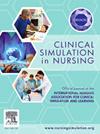采用探索性顺序混合方法设计开发模拟安全实践工具(SSPT)
IF 2.5
3区 医学
Q1 NURSING
引用次数: 0
摘要
目的评估一种工具的表面有效性,该工具可以评估学生在参与基于模拟的体验过程中的安全性。本研究是探索性顺序混合方法设计的第一阶段,用于开发一种工具,以支持本科护理学生在模拟中应用安全原则。方法从加拿大和美国的本科护理专业中招募10名模拟专家。进行了十次半结构化访谈来评估该工具的面部效度。主题分析使用Braun和Clarke的方法来识别和生成主题。基于参与者的反馈,工具被迭代地更新,直到最终的当前版本被创建。该工具有潜力支持本科护理学生在模拟环境中整合安全原则;因此,他们可能会将这种整合转移到临床环境中。本文章由计算机程序翻译,如有差异,请以英文原文为准。
Using exploratory sequential mixed methods design to develop simulation safety practice tool (SSPT)
Aim
To evaluate the face validity of a tool that assesses a student's safety during participation in simulation-based experiences.
Design
This study is the first phase of an exploratory sequential mixed methods design used for the development of a tool to support undergraduate nursing students' application of safety principles in simulation.
Method
The authors recruited 10 simulation experts from undergraduate nursing programs in Canada and the United States. Ten semi-structured interviews were conducted to assess the face validity of the tool. Thematic analysis was used to identify and generate themes using Braun and Clarke's approach.
Results
Based on feedback from the participants, the tool was updated iteratively until the final current version was created.
The tool has the potential to support undergraduate nursing students in integrating safety principles in simulation settings; therefore, they may transfer this integration into clinical settings.
求助全文
通过发布文献求助,成功后即可免费获取论文全文。
去求助
来源期刊

Clinical Simulation in Nursing
NURSING-
CiteScore
5.50
自引率
15.40%
发文量
107
期刊介绍:
Clinical Simulation in Nursing is an international, peer reviewed journal published online monthly. Clinical Simulation in Nursing is the official journal of the International Nursing Association for Clinical Simulation & Learning (INACSL) and reflects its mission to advance the science of healthcare simulation.
We will review and accept articles from other health provider disciplines, if they are determined to be of interest to our readership. The journal accepts manuscripts meeting one or more of the following criteria:
Research articles and literature reviews (e.g. systematic, scoping, umbrella, integrative, etc.) about simulation
Innovative teaching/learning strategies using simulation
Articles updating guidelines, regulations, and legislative policies that impact simulation
Leadership for simulation
Simulation operations
Clinical and academic uses of simulation.
 求助内容:
求助内容: 应助结果提醒方式:
应助结果提醒方式:


